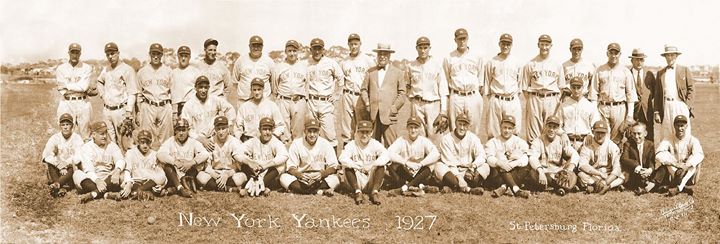
The 1927 New York Yankees -Murderer's Row
Murderer's Row -The origins
March 16, 2012
The year was 1913.
A young man of 23 years of age stood in front of the editor's desk in the office of the New York Globe.
He nervously clutched at the brim of his hat as the
editor looked over his letters of reference.
"You played some baseball?" asked the editor.
"Yes, Sir", said the young man. "back in '06 I played
semi-pro ball back in San Francisco for two years, a pitcher, but I had
to quit to support my mother, ..and"
"and?", asked the editor, not looking up.
"I played some this year for the New York Giants, until I broke my arm".
The editor looked up. "I'm looking for a sports cartoonist',
he said.
By late 1918 Robert Ripley was creating his sports cartoons, based on unusual athletic achievements, along with a collection of odd facts and feats under the title of "Champs and Chumps" in the New York Globe.
One day while drawing a cartoon about the 1918 Yankees,
he featured the lineup of Frank "Home Run" Baker, who led the Yanks
with 10 home runs, first bagger Wally Pipp, shortstop Roger Peckinpaugh,
leftfielder Duffy Lewis, who each belted 7 home runs, and centerfielder
Ping Bodie, who slugged 6 homers. Keep in mind this was the 'Dead Ball
Era of Baseball' and these home run totals were impressive. As Ripley drew
the exaggerated lineup with over sized bats and a fierce look, he titled
the cartoon - Murderer's Row.
The cartoon soon faded into obscurity.
Soon Richard Ripley's editor wanted a title that would describe the incredible nature of the sporting feats.
After much deliberation, Ripley changed "Champs and Chumps" to "Believe It or Not!"
The cartoons were an instant success! By 1936 millions of people were reading his cartoons and he was voted the most recognized man in America by the New York Times.
Nine years after Ripley's cartoon was published and faded into obscurity, an unknown New York sportswriter was writing an column on the 1927 Yankees.
While commenting on the first six batters in new lineup
Manager Miller Huggins announced for 1927: Centerfielder Earle Combs leading
off, followed by short-stop Mark Koenig, then the big bats of right-fielder
Babe Ruth and first-baseman Lou Gehrig, followed by left-fielder Bob Meusel
and then second-baseman Tony Lazzeri; the writer, reflected for a moment
and then called them: Murderer's Row.
This time the moniker stuck.
Today, the term Murderer's Row refers to only one team.
The greatest team in Baseball; the 1927 New York Yankees.
And now you know the rest of the story.
Believe it or not.

The 1927 New York Yankees -Murderer's Row